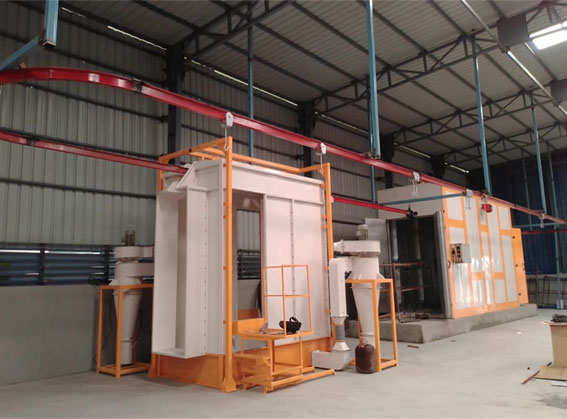The Role of Cathode Electro Deposition in Sustainable Manufacturing Practices

Cathode Electro Deposition (CED) is an environmentally friendly manufacturing technique that applies a protective coating to electrically conductive items while minimizing waste, using less toxic chemicals, and offering superior corrosion protection. It's essential for reducing the negative effects on the environment and inspiring sustainable production methods.
Understanding Cathode Electro Deposition
An electric current is used within the Cathode Electro Deposition (CED) process, which is employed in many industries to coat metal surfaces. This guarantees consistent and long-lasting coatings, especially on items with intricate shapes. Water-based paint or coating formulas, which are safe for the environment and do not contain any harmful ingredients, are often utilized materials in CED. Resins, pigments, and additives structure these compositions, which give them characteristics like color and resistance to corrosion. When water-based materials are compared to standard solvent-based procedures, the emission of volatile organic compounds (VOCs) is additionally decreased.
Environmental Benefits of CED
When compared to standard techniques, cathode Electro Deposition (CED) may be a very effective and ecologically benign approach. Employing water-based products and reducing overspray lowers emissions and waste while simultaneously lowering the quantity of toxic compounds within the environment. Because CED coats metal things with a large amount of electricity, it also consumes less energy and promotes a more sustainable production method. Furthermore, CED employs non-toxic materials since water-based paint and coating formulas are often barren of heavy metals and other dangerous ingredients, guaranteeing a safer workplace and minimizing possible harm to ecosystems and public health. CED promotes a more sustainable production process and a safer workplace.
Economic Advantages of cathode Electro Deposition
Cost-effective Benefits of CED are marked below:
- Economical: Enhances durability and corrosion resistance by applying a protective coating to metal surfaces through the utilization of an electrical current.
- Efficient material utilization minimizes material waste and saves money by ensuring uniform and controlled coating material deposition.
- Superior adhesion and coverage qualities: Offers a smooth, consistent finish, removing the necessity for extra finishing steps.
- High coverage capability improves the standard and appearance of the merchandise by lowering the prospect of coating flaws.
- Generally, Ageing Oven produces long-lasting, high-quality coatings while minimizing material waste and maintenance and replacement expenses.
Applications of Cathode Electro Deposition in Various Industries
In the automotive, aerospace, and electronics sectors, cathode electrodeposition—also mentioned as electrodeposition or electro coating—is a commonly employed method. It has several benefits and entails applying a protective coating to a metal surface with the utilization of an electrical current. It's utilized in the car sector to stop corrosion, guarantee uniform coating of car components, increase their longevity, and improve their look. Not only that, but it lowers the danger of structural damage and improves aircraft safety within the aerospace sector by providing a uniform and long-lasting coating on complexly shaped elements.
Furthermore, it improves the performance and dependability of electronic components within the industry by applying thin, homogeneous coatings, especially on computer circuit boards (PCBs) and semiconductor devices. On the requirements of the device, the tactic also permits the deposition of certain materials, like conductive or insulating coatings. Cathode electrodeposition may be a method that will be utilized in a good range of sectors and offers advantages, including improved electrical component performance, uniform coating on complex-shaped components, and protection against corrosion.
Innovations and Advancements in CED Technology
In recent years, breakthroughs have been witnessed in CED technology, with researchers concentrating on enhancing the efficacy and efficiency of the coating process. They need to create innovative techniques to enhance coating adherence, hamper waste, and maximize performance, which helps manufacturers and advances the event of a more environmentally friendly and sustainable manufacturing sector. Enhancing CED is usually hooked into research and development, where scientists create new materials, better coating formulas, and simpler application methods. Improvements in product quality, consumer happiness, and more dependable and long-lasting coatings have resulted from this ongoing study. To enhance efficiency, reduce human error, and expedite the coating process, future developments in CED technology will incorporate automated and intelligent technologies like robots, AI, and Internet of Things devices.
The Future of CED in Sustainable Manufacturing
Cathode Electro Deposition is predicted to possess a stable future in sustainable manufacturing thanks to growing demand for its advantages, which include greater durability, cost-effectiveness, and better corrosion resistance. Global manufacturing processes and individual businesses are going to be impacted by this increase. Collaboration between the world and policymakers is important to maximizing the potential of CED. Incentives for businesses to use CED technology should be offered by governments and regulatory agencies, and makers, academics, and other stakeholders should work together to share information and foster innovation. It appears that CED technology features a bright future before it. Continued study, development, and cooperation should end in more sustainable and productive manufacturing techniques.
Conclusion
Because it supports producers' objectives of cutting waste and limiting environmental effects, CED is important for sustainability. Manufacturers may help ensure a more sustainable manufacturing future by adopting CED. When widely used, CED may result in less waste, less use of dangerous chemicals, and better corrosion protection, making the manufacturing sector greener overall.
Note: IndiBlogHub features both user-submitted and editorial content. We do not verify third-party contributions. Read our Disclaimer and Privacy Policyfor details.






